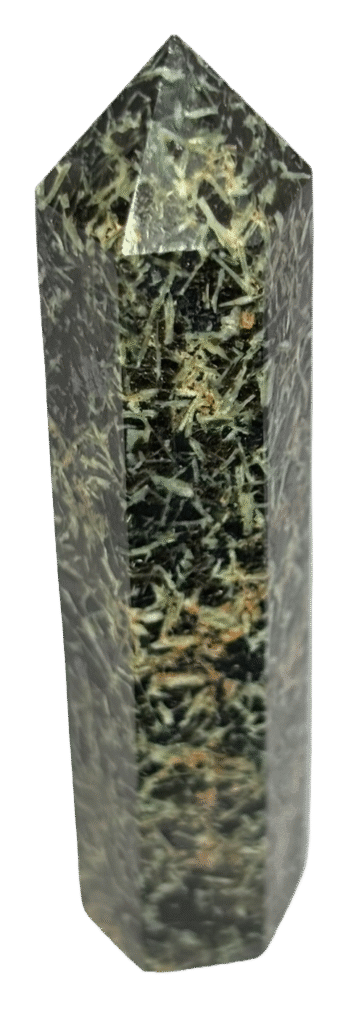
The name “tourmaline” comes from the Sinhalese word “toramalli,” meaning “mixed gems,” as early traders in Sri Lanka found various coloured tourmalines among other gemstones. Tourmaline in matrix refers to tourmaline crystals embedded in their natural host rock, often quartz, feldspar, or granite. The matrix enhances the structural integrity of the tourmaline and creates visually striking mineral specimens.
Composition and Formation
Tourmaline is a complex borosilicate mineral with the general formula (XY)₃Z₆(T₆O₁₈)(BO₃)₃V₃W, where its elements vary to produce different colours. It often forms in igneous and metamorphic rocks through hydrothermal processes, where boron-rich fluids interact with surrounding minerals.
Common matrices for tourmaline include:
- Quartz – Provides a strong, clear or milky backdrop.
- Granite or Feldspar – Adds contrast and texture.
- Lepidolite or Mica Schist – Creates shimmering effects.
Locations and Sources
Tourmaline in matrix is found in many major tourmaline-producing regions, including:
- Brazil – One of the world’s most famous sources.
- Madagascar – Produces vibrant pink and green tourmaline in white quartz.
- Afghanistan & Pakistan – Known for bright multi-coloured tourmalines in matrix.
- USA (Maine & California) – Notable for watermelon tourmaline in pegmatite.
- Namibia & Nigeria – Yield high-quality specimens in granite.
Physical Characteristics
- Colour: Tourmaline occurs in a wide range of colours, from black (schorl) to pink, green, blue, and even multi-coloured crystals.
- Lustre: Vitreous to slightly resinous.
- Hardness: 7 – 7.5 on the Mohs scale, making it durable for jewellery.
- Crystal System: Trigonal, often forming elongated prismatic crystals.
- Transparency: Varies from opaque to transparent.
- Cleavage: None, but exhibits conchoidal fracturing.
The matrix provides additional stability to the often fragile tourmaline crystals, making specimens easier to handle and cut for jewellery or display.
Archaeological Finds and Historical Usage
Tourmaline has been used for centuries in jewellery and decorative carvings. Some notable historical uses include:
- Ancient China: Used for carved talismans and imperial jewellery.
- Egyptian Civilisation: Believed to have protective and mystical properties.
- Colonial Era: Dutch traders brought tourmaline to Europe, mistaking it for other gems.
- Victorian Era: Popular for mourning jewellery, especially black tourmaline (schorl).
Tourmaline in matrix is often collected in its raw mineral form rather than being carved or cut, making it highly desirable for collectors and crystal enthusiasts.
Modern Applications
- Jewellery – Unique designs incorporate natural matrix formations.
- Metaphysical Healing – Used for energy balancing and grounding.
- Interior Design – Display specimens used for aesthetic and energetic enhancement.
- Scientific Research – Studied for its piezoelectric and pyroelectric properties.
Interesting Facts
- Tourmaline can become electrically charged when heated or rubbed, a property known as pyroelectricity.
- Some pink and green tourmaline combinations resemble watermelon, giving rise to the name “watermelon tourmaline.”
- Tourmaline is one of the few crystals that can form in a rainbow of colours within a single crystal.
Folklore, Legends, and Tales
Tourmaline has long been associated with protection, creativity, and emotional healing:
- Ancient Egyptian legend states that tourmaline travelled through a rainbow on its journey from the Earth’s core, explaining its wide colour variety.
- Medieval healers believed black tourmaline could ward off evil spirits and negative energy.
- Some Native American tribes viewed tourmaline as a stone of friendship and good communication.
Links with Astrology and the Chakra System
Astrology
Tourmaline is associated with Libra, Scorpio, and Capricorn, aiding balance, transformation, and grounding. Different colours resonate with different zodiac signs.
Chakra System
- Black Tourmaline in Matrix – Root chakra (protection and grounding).
- Pink Tourmaline in Matrix – Heart chakra (love and emotional healing).
- Blue Tourmaline in Matrix – Throat chakra (communication and self-expression).
- Green Tourmaline in Matrix – Heart chakra (growth and renewal).

Tourmaline in Matrix
Tourmaline in Matrix grounds protective energy within earthy stability. A powerful ally for shielding, emotional cleansing, and anchoring spiritual strength.
